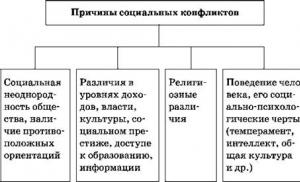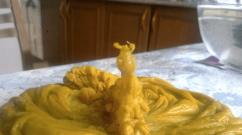What is the state of aggregation of the matter of stars. Aggregate state of substances
Lesson objectives:
- to deepen and generalize knowledge about the state of aggregation of matter, to study in what states substances can be.
Lesson Objectives:
Educational - to formulate an idea of the properties of solids, gases, liquids.
Developing - the development of students' skills in speech, analysis, conclusions based on the passed and studied material.
Educational - instilling mental labor, creating all conditions to increase interest in the subject studied.
Basic terms:
State of aggregation- this is the state of a substance, which is characterized by certain qualitative properties: - the ability or inability to maintain shape and volume; - presence or absence of short-range and long-range order; - others.
Fig. 6. Aggregate state of matter when the temperature changes.
When a substance passes from a solid state to a liquid, then this is called melting, the reverse process is crystallization. When a substance passes from a liquid to a gas, this process is called vaporization, to a liquid from a gas - condensation. And the transition directly into gas from a solid, bypassing the liquid - by sublimation, the reverse process - by desublimation.
1.Crystallization; 2. Melting; 3. Condensation; 4. Steam generation;
5. Sublimation; 6. Desublimation.
We constantly see these examples of transitions in everyday life. When ice melts, it turns into water, and the water in turn evaporates and steam is formed. If we look in the opposite direction, the steam, condensing, begins to pass again into water, and the water, in turn, freezing, becomes ice. The smell of any solid is sublimation. Part of the molecules is escaped from the body, while a gas is formed, which gives the smell. An example of the reverse process is patterns on glass in winter, when vapor in the air settles on the glass when it freezes.
The video shows the change in the state of aggregation of matter.
Control block.
1.After freezing, the water turned into ice. Have the water molecules changed?
2.In the room they use medical air. And because of this, they usually smell strong there. What is the state of the ether?
3.What happens to the shape of the liquid?
4. Ice. What is the condition of the water?
5.What happens when water freezes?
Homework.
Answer the questions:
1.Can you fill half the volume of the vessel with gas? Why?
2.Can nitrogen and oxygen be in a liquid state at room temperature?
3.Can they be in a gaseous state at room temperature: iron and mercury?
4. On a frosty winter day, fog formed over the river. What is this state of matter?
We believe that a substance has three states of aggregation. In fact, there are at least fifteen of them, while the list of these conditions continues to grow every day. These are: amorphous solid, solid, neutronium, quark-gluon plasma, strongly symmetric matter, weakly symmetric matter, fermionic condensate, Bose-Einstein condensate and strange matter.
Everyone, I think, knows 3 basic states of aggregation: liquid, solid and gaseous. We encounter these states of matter every day and everywhere. Most often they are considered using the example of water. The liquid state of water is most familiar to us. We constantly drink liquid water, it flows from our tap, and we ourselves are 70% liquid water. The second aggregate state of water is ordinary ice, which we see on the street in winter. In gaseous form, water is also easy to find in everyday life. In a gaseous state, water is, as we all know, steam. It can be seen when, for example, we are boiling a kettle. Yes, it is at 100 degrees that water changes from a liquid to a gaseous state.
These are the three aggregate states of matter that are familiar to us. But did you know that there are actually 4 of them? I think that at least once everyone has heard the word “ plasma". And today I want you to also learn more about plasma - the fourth state of aggregation of matter.
Plasma is a partially or fully ionized gas with the same density of both positive and negative charges. Plasma can be obtained from gas - from the 3 state of aggregation of matter by strong heating. The state of aggregation in general, in fact, is completely dependent on temperature. The first state of aggregation is the lowest temperature at which the body retains its hardness, the second state of aggregation is the temperature at which the body begins to melt and become liquid, the third state of aggregation is the highest temperature, at which the substance becomes gas. For each body, substance, the temperature of the transition from one state of aggregation to another is completely different, for some it is lower, for some it is higher, but for everyone it is strictly in this sequence. And at what temperature does the substance become plasma? Since this is the fourth state, it means that the transition temperature to it is higher than that of each previous one. And indeed it is. In order to ionize a gas, a very high temperature is required. The lowest-temperature and low-ionized (about 1%) plasma is characterized by temperatures up to 100 thousand degrees. In terrestrial conditions, such a plasma can be observed in the form of lightning. The temperature of the lightning channel can exceed 30 thousand degrees, which is 6 times higher than the temperature of the sun's surface. By the way, the Sun and all other stars are also plasma, more often they are high-temperature ones. Science proves that about 99% of all matter in the Universe is plasma.
Unlike low-temperature plasma, high-temperature plasma has almost 100% ionization and temperatures up to 100 million degrees. This is truly stellar temperature. On Earth, such a plasma is found only in one case - for experiments in thermo-nuclear synthesis. Con-tro-li-ru-e-may the reaction is quite complicated and energy-consuming, but the non-con-tro-li-ru-e-may is enough-dawn-co-men-before - she felt herself like a weapon of colossal power - a thermo-nuclear bomb, tested by the USSR on August 12, 1953.
Plasma is classified not only by temperature and degree of ionization, but also by density and quasi-neutrality. Collocation plasma density usually means electron density, that is, the number of free electrons per unit volume. Well, with this, I think everything is clear. But not everyone knows what quasineutrality is. Plasma quasineutrality is one of its most important properties, which consists in the practically exact equality of the densities of the positive ions and electrons included in its composition. Due to the good electrical conductivity of the plasma, the separation of positive and negative charges is impossible at distances of large Debye lengths and times of large periods of plasma oscillations. Almost all plasma is quasineutral. An example of a non-quasi-neutral plasma is an electron beam. However, the density of non-neutral plasmas must be very low, otherwise they will quickly decay due to Coulomb repulsion.
We have considered very few terrestrial examples of plasma. But there are a lot of them. Man has learned to use plasma for his own good. Thanks to the fourth aggregate state of matter, we can use gas-discharge lamps, plasma television zo-rams, arc-howling electric-welding, lasers. Conventional gas-discharge fluorescent lamps are also plasma. There is also a plasma lamp in our world. It is mainly used in science to study, and most importantly, see some of the more complex plasma phenomena, including filamentation. A photograph of such a lamp can be seen in the picture below:

In addition to household plasma devices, natural plasma can also often be seen on Earth. We have already spoken about one of her examples. This is lightning. But apart from lightning, plasma phenomena can be called the aurora borealis, “the lights of St. Elmo,” the Earth's ionosphere and, of course, fire.

Notice that fire and lightning and other manifestations of plasma, as we call it, are on fire. What is the reason for such a bright emission of light from a plasma? Plasma glow is caused by the transition of electrons from a high-energy state to a low-energy state after recombination with ions. This process results in radiation with a spectrum corresponding to the gas being excited. This is why plasma glows.
I would also like to tell a little about the history of plasma. After all, once only substances such as the liquid component of milk and the colorless component of blood were called plasma. Everything changed in 1879. It was in that year that the famous English scientist William Crookes, while studying electrical conductivity in gases, discovered the phenomenon of plasma. True, this state of matter was called plasma only in 1928. And this was done by Irving Langmuir.
In conclusion, I want to say that such an interesting and mysterious phenomenon as ball lightning, which I have written about on this site more than once, is, of course, also a plasmoid, like ordinary lightning. This is perhaps the most unusual plasmoid of all terrestrial plasma phenomena. After all, there are about 400 very different theories about ball lightning, but not one of them has been recognized as truly correct. In laboratory conditions, similar, but short-term phenomena were obtained in several different ways, so the question of the nature of ball lightning remains open.
Conventional plasma, of course, was also created in laboratories. Once it was difficult, but now such an experiment is not difficult. Since plasma has become a part of our household arsenal, a lot of experiments are being done on it in laboratories.
Experiments with plasma in zero gravity became an interesting discovery in the field of plasma. It turns out that plasma crystallizes in a vacuum. It happens like this: charged plasma particles begin to repel each other, and when they have a limited volume, they occupy the space that is allotted to them, scattering in different directions. It looks a lot like a crystal lattice. Does this not mean that plasma is the closing link between the first state of aggregation of matter and the third? After all, it becomes a plasma due to the ionization of the gas, and in a vacuum the plasma again becomes, as it were, solid. But this is just my guess.
Plasma crystals in space also have a rather strange structure. This structure can be observed and studied only in space, in a real cosmic vacuum. Even if you create a vacuum on Earth and put plasma there, then gravity will simply squeeze the whole "picture" that is formed inside. In space, plasma crystals simply take off, forming a three-dimensional three-dimensional structure of a strange shape. After sending the results of observations of plasma in orbit to terrestrial scientists, it turned out that the vortices in the plasma in a strange way repeat the structure of our galaxy. This means that in the future it will be possible to understand how our galaxy originated by studying plasma. The photographs below show the same crystallized plasma.

That's all I would like to say about plasma. I hope you are interested and surprised by it. After all, this is truly an amazing phenomenon, or rather a state - the 4th aggregate state of matter.
The state of aggregation of a substance is usually called its ability to maintain its shape and volume. An additional feature is the ways of transition of a substance from one state of aggregation to another. Based on this, three states of aggregation are distinguished: solid, liquid and gas. Their visible properties are as follows:
Solid - retains both shape and volume. It can pass both into a liquid by melting and directly into a gas by sublimation.
- Liquid - retains volume, but not shape, that is, it has fluidity. The spilled liquid tends to spread indefinitely over the surface onto which it is poured. A liquid can pass into a solid by crystallization, and into a gas by evaporation.
- Gas - retains neither shape nor volume. Gas outside any container tends to expand indefinitely in all directions. Only gravity can prevent him from doing this, thanks to which the earth's atmosphere does not dissipate into space. The gas passes into a liquid by condensation, and can go directly into a solid by precipitation.
Phase transitions
The transition of a substance from one state of aggregation to another is called a phase transition, since the scientific state of aggregation is the phase of a substance. For example, water can exist in solid phase (ice), liquid (ordinary water) and gaseous (water vapor).
The example of water is also well demonstrated. Hanging out in the yard to dry on a frosty windless day immediately freezes, but after a while it turns out to be dry: the ice sublimates, directly passing into water vapor.
As a rule, the phase transition from a solid to a liquid and a gas requires heating, but the temperature of the medium does not increase in this case: thermal energy is spent on breaking the internal bonds in the substance. This is the so-called latent heat. During reverse phase transitions (condensation, crystallization), this heat is released.
That is why steam burns are so dangerous. On contact with the skin, it condenses. The latent heat of evaporation / condensation of water is very high: water in this respect is an abnormal substance; that is why life on Earth is possible. In case of a steam burn, the latent heat of condensation of water "scald" the burned place very deeply, and the consequences of a steam burn are much more severe than from a flame on the same area of the body.
Pseudophases
The fluidity of the liquid phase of a substance is determined by its viscosity, and the viscosity is determined by the nature of the internal bonds, to which the next section is devoted. The viscosity of the liquid can be very high and the liquid can flow unnoticed by the eye.
Glass is a classic example. It is not a solid, but a very viscous liquid. Please note that glass sheets in warehouses are never stored obliquely against a wall. Within a few days they will bend under their own weight and will be unusable.
Other pseudo-solids are shoemaking and construction. If you forget the angular piece on the roof, over the summer it will spread into a cake and stick to the base. Pseudo-solid bodies can be distinguished from real ones by the nature of melting: during it, real ones either retain their shape until they spread at once (solder at), or float, letting in puddles and rivulets (ice). And very viscous liquids gradually soften, like the same pitch or bitumen.
Plastics are extremely viscous liquids that have not been noticeable for many years and decades. Their high ability to retain their shape is provided by the huge molecular weight of the polymers, in many thousands and millions of hydrogen atoms.
Phase structure of matter
In the gas phase, molecules or atoms of a substance are very far apart from each other, many times greater than the distance between them. They interact with each other occasionally and irregularly, only in collisions. The interaction itself is elastic: they collided like solid balls, and then flew away.
In a liquid, molecules / atoms constantly "feel" each other due to very weak bonds of a chemical nature. These bonds break all the time and are immediately restored again, the molecules of the liquid are continuously moving relative to each other, so the liquid flows. But in order to turn it into a gas, you need to break all bonds at once, and this requires a lot of energy, because the liquid retains its volume.
In this respect, water differs from other substances in that its molecules in a liquid are linked by so-called hydrogen bonds, which are quite strong. Therefore, water can be a liquid at a temperature normal for life. Many substances with molecular weights tens and hundreds of times greater than that of water, under normal conditions are gases, just like ordinary household gas.
In a solid, all of its molecules are firmly in place due to strong chemical bonds between them, forming a crystal lattice. Crystals of the correct shape require special conditions for their growth and therefore are rarely found in nature. Most solids are conglomerates of small and minute crystals - crystallites, firmly linked by forces of mechanical and electrical nature.
If the reader has ever seen, for example, a cracked semi-axle of a car or a cast-iron grate, then the grains of crystallites on the fracture are visible there with the naked eye. And on the fragments of broken porcelain or earthenware, they can be observed under a magnifying glass.
Plasma
Physicists also distinguish the fourth state of aggregation of matter - plasma. In plasma, electrons are torn away from atomic nuclei, and it is a mixture of electrically charged particles. Plasma can be very dense. For example, one cubic centimeter of plasma from the bowels of stars - white dwarfs, weighs tens and hundreds of tons.
Plasma is isolated into a separate state of aggregation because it actively interacts with electromagnetic fields due to the fact that its particles are charged. In free space, the plasma tends to expand, cooling down and turning into a gas. But under the influence, it can retain its shape and volume outside the vessel, like a solid. This property of plasma is used in thermonuclear power reactors - prototypes of power plants of the future.
State of matter
Substance- a really existing set of particles connected with each other by chemical bonds and under certain conditions in one of the aggregate states. Any substance consists of a collection of a very large number of particles: atoms, molecules, ions, which can combine with each other into associates, also called aggregates or clusters. Depending on the temperature and behavior of particles in associates (mutual arrangement of particles, their number and interaction in an associate, as well as the distribution of associates in space and their interaction with each other), a substance can be in two basic states of aggregation - crystalline (solid) or gaseous, and in transitional states of aggregation - amorphous (solid), liquid crystal, liquid and vapor. Solid, liquid crystal and liquid states of aggregation are condensed, and vapor and gaseous states are highly discharged.
Phase Is a set of homogeneous microregions characterized by the same ordering and concentration of particles and enclosed in a macroscopic volume of a substance bounded by the interface. In this understanding, the phase is characteristic only for substances in crystalline and gaseous states, since these are homogeneous states of aggregation.
Metaphase Is a set of dissimilar microregions that differ from each other in the degree of ordering of particles or their concentration and are enclosed in a macroscopic volume of a substance bounded by the interface. In this understanding, metaphase is characteristic only for substances in heterogeneous transitional states of aggregation. Different phases and metaphases can mix between each other, forming one aggregate state, and then there is no interface between them.
Usually, the concepts of "ground" and "transitional" aggregate states are not separated. The concepts of "state of aggregation", "phase" and "mesophase" are often used interchangeably. It is advisable to consider five possible aggregate states for the state of substances: solid, liquid crystal, liquid, vapor, gaseous. The transition from one phase to another phase is called a first-order and second-order phase transition. Phase transitions of the first kind are characterized by:
An abrupt change in physical grandeur, describing the state of matter (volume, density, viscosity, etc.);
A certain temperature at which this phase transition occurs
A certain warmth, which characterizes this transition, because intermolecular bonds are broken.
Phase transitions of the first kind are observed during the transition from one state of aggregation to another state of aggregation. Phase transitions of the second kind are observed with a change in the ordering of particles within one aggregate state, characterized by:
A gradual change in the physical properties of a substance;
Changes in the ordering of particles of a substance under the influence of a gradient of external fields or at a certain temperature, called the temperature of the phase transition;
The heat of second-order phase transitions is equal and close to zero.
The main difference between the phase transitions of the first and second order is that during first-order transitions, first of all, the energy of the particles of the system changes, and in the case of second-order transitions, the ordering of the particles of the system.
The transition of a substance from a solid state to a liquid is called melting and is characterized by a melting point. The transition of a substance from a liquid to a vapor state is called evaporation and is characterized by a boiling point. For some substances with a low molecular weight and weak intermolecular interaction, a direct transition from a solid to a vapor state is possible, bypassing the liquid state. This transition is called sublimation. All of these processes can also proceed in the opposite direction: then they are called freezing, condensation, desublimation.
Substances that do not decompose during melting and boiling can be, depending on temperature and pressure, in all four states of aggregation.
Solid state
At a sufficiently low temperature, almost all substances are in a solid state. In this state, the distance between the particles of a substance is comparable to the size of the particles themselves, which ensures their strong interaction and a significant excess of their potential energy over kinetic energy .. The movement of particles of a solid is limited only by minor vibrations and rotations relative to the position occupied, and they have no translational motion ... This leads to internal orderliness in the arrangement of particles. Therefore, solids are characterized by their own shape, mechanical strength, constant volume (they are practically incompressible). Depending on the degree of ordering of the particles, solids are divided into crystalline and amorphous.
Crystalline substances are characterized by the presence of order in the arrangement of all particles. The solid phase of crystalline substances consists of particles that form a homogeneous structure characterized by a strict repeatability of the same unit cell in all directions. The unit cell of a crystal characterizes the three-dimensional periodicity in the arrangement of particles, i.e. its crystal lattice. Crystalline lattices are classified according to the type of particles that make up the crystal and the nature of the forces of attraction between them.

Many crystalline substances, depending on the conditions (temperature, pressure), can have a different crystal structure. This phenomenon is called polymorphism. Well-known polymorphic modifications of carbon: graphite, fullerene, diamond, carbyne.

Amorphous (shapeless) substances. This condition is typical for polymers. Long molecules easily bend and intertwine with other molecules, resulting in irregular particle arrangement.
The difference between amorphous and crystalline particles:
isotropy - the same physical and chemical properties of a body or environment in all directions, i.e. independence of properties from direction;
no fixed melting point.
Glass, fused silica, and many polymers have an amorphous structure. Amorphous substances are less stable than crystalline ones, and therefore any amorphous body can eventually pass into an energetically more stable state - crystalline.
Liquid state
With an increase in temperature, the energy of thermal vibrations of particles increases, and for each substance there is a temperature, starting from which the energy of thermal vibrations exceeds the energy of bonds. The particles can make different movements, moving relative to each other. They still remain in contact, although the correct geometric structure of the particles is violated - the substance exists in a liquid state. Due to the mobility of particles, the liquid state is characterized by Brownian motion, diffusion and volatility of particles. An important property of a fluid is viscosity, which characterizes the inter-associative forces that impede the free flow of the fluid.
Liquids occupy an intermediate position between the gaseous and solid state of substances. More ordered structure than gas, but less than solid.
Steam and gaseous state
The vapor-gaseous state is usually not distinguished.
Gas - it is a highly discharged homogeneous system consisting of individual molecules far removed from each other, which can be considered as a single dynamic phase.
Steam - it is a highly discharged inhomogeneous system, which is a mixture of molecules and unstable small associates consisting of these molecules.
Molecular kinetic theory explains the properties of an ideal gas, based on the following provisions: molecules make continuous random motion; the volume of gas molecules is negligible compared to the intermolecular distances; forces of attraction or repulsion do not act between gas molecules; the average kinetic energy of gas molecules is proportional to its absolute temperature. Due to the insignificance of the forces of intermolecular interaction and the presence of a large free volume, gases are characterized by a high rate of thermal motion and molecular diffusion, the desire of molecules to occupy the largest possible volume, as well as high compressibility.
An isolated gas-phase system is characterized by four parameters: pressure, temperature, volume, amount of substance. The relationship between these parameters is described by the ideal gas equation of state:
R = 8.31 kJ / mol - universal gas constant.

The most common knowledge about three states of aggregation: liquid, solid, gaseous, sometimes remember about plasma, less often liquid crystal. Recently, a list of 17 phases of a substance, taken from the famous () Stephen Fry, has spread on the Internet. Therefore, we will tell you more about them, because you should know a little more about matter, if only in order to better understand the processes taking place in the Universe.
The list of aggregate states of matter given below increases from the coldest states to the hottest, and so on. can be continued. At the same time, it should be understood that the degree of compression of the substance and its pressure (with some reservations for such unexplored hypothetical states such as quantum, radial, or weakly symmetric) increase from the gaseous state (No. 11), the most "unclenched", to both sides of the list. a visual graph of the phase transitions of matter is shown.
1. Quantum- the aggregate state of matter, achieved when the temperature drops to absolute zero, as a result of which internal bonds disappear and matter disintegrates into free quarks.
2. Bose-Einstein condensate- the aggregate state of matter, which is based on bosons cooled to temperatures close to absolute zero (less than a millionth of a degree above absolute zero). In such a strongly cooled state, a sufficiently large number of atoms find themselves in their minimum possible quantum states and quantum effects begin to manifest themselves at the macroscopic level. Bose-Einstein condensate (often called "Bose condensate", or simply "back") occurs when you cool a chemical element to extremely low temperatures (usually to a temperature slightly above absolute zero, minus 273 degrees Celsius , Is the theoretical temperature at which everything stops moving).
This is where completely strange things begin to happen to the substance. Processes normally only seen at the atomic level now take place on a scale large enough to be observed with the naked eye. For example, if you put the “backing” in a beaker and provide the required temperature, the substance will begin to crawl up the wall and eventually will get out by itself.
Apparently, here we are dealing with a futile attempt by the substance to lower its own energy (which is already at the lowest of all possible levels).
Slowing down the atoms using cooling equipment produces a singular quantum state known as a Bose condensate, or Bose-Einstein condensate. This phenomenon was predicted in 1925 by A. Einstein, as a result of a generalization of the work of S. Bose, where statistical mechanics was built for particles ranging from massless photons to atoms with mass (Einstein's manuscript, which was considered lost, was discovered in the library of Leiden University in 2005 ). The result of the efforts of Bose and Einstein was the concept of Bose gas obeying Bose-Einstein statistics, which describes the statistical distribution of identical particles with integer spin, called bosons. Bosons, which are, for example, and individual elementary particles - photons, and whole atoms, can be with each other in the same quantum states. Einstein suggested that cooling atoms - bosons to very low temperatures would force them to go (or, in other words, condense) into the lowest possible quantum state. The result of such condensation will be the emergence of a new form of matter.
This transition occurs below the critical temperature, which is for a homogeneous three-dimensional gas consisting of non-interacting particles without any internal degrees of freedom.
3. Fermion condensate- the state of aggregation of a substance, similar to the backing, but differing in structure. When approaching absolute zero, atoms behave differently depending on the magnitude of the proper angular momentum (spin). Bosons have integer spins, while fermions have multiples of 1/2 (1/2, 3/2, 5/2). Fermions obey the Pauli exclusion principle, according to which two fermions cannot have the same quantum state. There is no such prohibition for bosons, and therefore they have the opportunity to exist in one quantum state and thereby form the so-called Bose-Einstein condensate. The formation of this condensate is responsible for the transition to the superconducting state.
Electrons have spin 1/2 and are therefore fermions. They combine into pairs (called Cooper pairs), which then form a Bose condensate.
American scientists have attempted to obtain a kind of molecule from fermion atoms with deep cooling. The difference from real molecules was that there was no chemical bond between the atoms - they just moved together in a correlated manner. The bond between atoms turned out to be even stronger than between electrons in Cooper pairs. For the formed pairs of fermions, the total spin is no longer a multiple of 1/2; therefore, they already behave like bosons and can form a Bose condensate with a single quantum state. In the course of the experiment, a gas of potassium-40 atoms was cooled to 300 nanokelvin, while the gas was contained in a so-called optical trap. Then an external magnetic field was imposed, with the help of which it was possible to change the nature of interactions between atoms - instead of a strong repulsion, a strong attraction began to be observed. When analyzing the influence of the magnetic field, it was possible to find its value at which the atoms began to behave like Cooper pairs of electrons. At the next stage of the experiment, scientists propose to obtain the effects of superconductivity for fermion condensate.
4. Superfluid substance- a state in which a substance has virtually no viscosity, and during flow it does not experience friction with a solid surface. The consequence of this is, for example, such an interesting effect as the complete spontaneous "creeping" of superfluid helium from the vessel along its walls against the force of gravity. Of course, there is no violation of the law of conservation of energy. In the absence of friction forces, only gravity, the forces of interatomic interaction between helium and the walls of the vessel and between helium atoms act on helium. So, the forces of interatomic interaction exceed all other forces combined. As a result, helium tends to spread as much as possible over all possible surfaces, and therefore "travels" along the walls of the vessel. In 1938, the Soviet scientist Pyotr Kapitsa proved that helium can exist in a superfluid state.
It is worth noting that many of the unusual properties of helium have been known for quite some time. However, in recent years this chemical element has been “spoiling” us with interesting and unexpected effects. So, in 2004, Moses Chan and Eun-Siong Kim from the University of Pennsylvania intrigued the scientific world with the statement that they had managed to obtain a completely new state of helium - a superfluid solid. In this state, some helium atoms in the crystal lattice can flow around others, and thus helium can flow through itself. The "superhardness" effect was theoretically predicted back in 1969. And now in 2004 - as if it was an experimental confirmation. However, later and very interesting experiments showed that not everything is so simple, and, perhaps, such an interpretation of the phenomenon, which was previously taken for the superfluidity of solid helium, is incorrect.
The experiment of scientists led by Humphrey Maris from Brown University in the United States was simple and elegant. Scientists placed a test tube upside down in a closed reservoir of liquid helium. Some of the helium in the test tube and in the reservoir was frozen in such a way that the boundary between liquid and solid inside the test tube was higher than in the reservoir. In other words, in the upper part of the test tube there was liquid helium, in the lower part - solid, it smoothly passed into the solid phase of the reservoir, over which a little liquid helium was poured - lower than the liquid level in the test tube. If liquid helium began to seep through solid, then the level difference would decrease, and then we can talk about solid superfluid helium. And in principle, in three of the 13 experiments, the level difference actually decreased.
5. Superhard substance- an aggregate state in which matter is transparent and can "flow" like a liquid, but in fact it is devoid of viscosity. Such fluids have been known for many years and are called superfluids. The fact is that if the superfluid is stirred, it will circulate almost forever, while the normal liquid will eventually calm down. The first two superfluids were created by the researchers using helium-4 and helium-3. They were cooled to almost absolute zero - to minus 273 degrees Celsius. And from helium-4, American scientists managed to get a superhard body. They compressed the frozen helium by more than 60 times pressure, and then the glass filled with the substance was placed on a rotating disk. At a temperature of 0.175 degrees Celsius, the disk suddenly began to spin more freely, which, according to scientists, indicates that helium has become a superbody.
6. Solid- the aggregate state of matter, characterized by the stability of the form and the nature of the thermal motion of atoms, which perform small vibrations around the equilibrium positions. The stable state of solids is crystalline. Distinguish between solids with ionic, covalent, metallic and other types of bonds between atoms, which determines the variety of their physical properties. Electrical and some other properties of solids are mainly determined by the nature of the movement of the outer electrons of its atoms. According to their electrical properties, solids are divided into dielectrics, semiconductors and metals, according to their magnetic properties - into diamagnets, paramagnets and bodies with an ordered magnetic structure. Research into the properties of solids has united into a large area - solid state physics, the development of which is stimulated by the needs of technology.
7. Amorphous solid- condensed aggregate state of matter, characterized by isotropy of physical properties due to the disordered arrangement of atoms and molecules. In amorphous solids, atoms vibrate around randomly located points. In contrast to the crystalline state, the transition from solid amorphous to liquid occurs gradually. Various substances are in the amorphous state: glasses, resins, plastics, etc.
8. Liquid crystal Is a specific aggregate state of a substance in which it simultaneously exhibits the properties of a crystal and a liquid. Immediately it is necessary to make a reservation that not all substances can be in a liquid crystal state. However, some organic substances with complex molecules can form a specific aggregate state - liquid crystal. This state occurs when crystals of some substances melt. When they melt, a liquid crystal phase is formed, which differs from ordinary liquids. This phase exists in the range from the melting point of the crystal to some higher temperature, when heated to which the liquid crystal transforms into an ordinary liquid.
How does a liquid crystal differ from a liquid and an ordinary crystal, and how is it similar to them? Like an ordinary liquid, a liquid crystal is fluid and takes the form of a vessel in which it is placed. In this it differs from the crystals known to all. However, despite this property, which unites it with a liquid, it has a property characteristic of crystals. This is the ordering in space of the molecules that form the crystal. True, this ordering is not as complete as in ordinary crystals, but, nevertheless, it significantly affects the properties of liquid crystals, which distinguishes them from ordinary liquids. Incomplete spatial ordering of the molecules that form a liquid crystal is manifested in the fact that in liquid crystals there is no complete order in the spatial arrangement of the centers of gravity of molecules, although there may be a partial order. This means that they do not have a rigid crystal lattice. Therefore, liquid crystals, like ordinary liquids, have the property of fluidity.
An obligatory property of liquid crystals, bringing them closer to ordinary crystals, is the presence of the order of the spatial orientation of molecules. This order in orientation can manifest itself, for example, in the fact that all long axes of molecules in a liquid crystal sample are oriented in the same way. These molecules must be elongated. In addition to the simplest named ordering of the molecular axes, a more complex orientational order of molecules can be realized in a liquid crystal.
Depending on the type of ordering of the molecular axes, liquid crystals are divided into three types: nematic, smectic, and cholesteric.
Research in the physics of liquid crystals and their applications is currently being carried out on a broad front in all the most developed countries of the world. Domestic research is concentrated in both academic and industrial research institutions and has a long tradition. The works of V.K. Fredericks to V.N. Tsvetkova. In recent years, the vigorous study of liquid crystals, Russian researchers have also made a significant contribution to the development of the theory of liquid crystals in general and, in particular, of the optics of liquid crystals. Thus, the works of I.G. Chistyakova, A.P. Kapustina, S.A. Brazovsky, S.A. Pikina, L.M. Blinov and many other Soviet researchers are widely known to the scientific community and serve as the foundation for a number of effective technical applications of liquid crystals.
The existence of liquid crystals was established a very long time ago, namely in 1888, that is, almost a century ago. Although scientists were faced with this state of matter before 1888, it was officially discovered later.
The first to discover liquid crystals was the Austrian botanist Reinitzer. Investigating the new substance he synthesized, cholesteryl benzoate, he found that at a temperature of 145 ° C, the crystals of this substance melt, forming a turbid liquid, strongly scattering light. As the heating continues, upon reaching a temperature of 179 ° C, the liquid clears up, that is, it begins to behave optically like an ordinary liquid, for example water. Cholesteryl benzoate exhibited unexpected properties in a cloudy phase. Examining this phase under a polarizing microscope, Rey-nitzer discovered that it has birefringence. This means that the refractive index of light, that is, the speed of light in this phase, depends on the polarization.
9. Liquid- the state of aggregation of a substance, which combines the features of a solid state (retention of volume, a certain tensile strength) and gaseous (variability of shape). A liquid is characterized by short-range order in the arrangement of particles (molecules, atoms) and a small difference in the kinetic energy of the thermal motion of molecules and their potential interaction energy. The thermal motion of liquid molecules consists of oscillations about equilibrium positions and relatively rare jumps from one equilibrium position to another, which is associated with the fluidity of the liquid.
10. Supercritical fluid(SCF) - the state of aggregation of a substance, in which the difference between the liquid and gas phases disappears. Any substance at a temperature and pressure above the critical point is a supercritical fluid. The properties of a substance in a supercritical state are intermediate between its properties in the gas and liquid phases. So, SCF has a high density, close to a liquid, and a low viscosity, like gases. In this case, the diffusion coefficient has an intermediate value between liquid and gas. Supercritical substances can be used as substitutes for organic solvents in laboratory and industrial processes. Supercritical water and supercritical carbon dioxide have received the greatest interest and distribution in connection with certain properties.
One of the most important properties of the supercritical state is the ability to dissolve substances. By changing the temperature or pressure of the fluid, you can change its properties in a wide range. So, you can get a fluid that is close in properties to either a liquid or a gas. Thus, the dissolving ability of a fluid increases with increasing density (at a constant temperature). Since the density increases with increasing pressure, changing the pressure can affect the dissolving ability of the fluid (at constant temperature). In the case of temperature, the envy of the properties of the fluid is somewhat more complicated - at a constant density, the dissolving ability of the fluid also increases, however, near the critical point, a slight increase in temperature can lead to a sharp drop in density, and, accordingly, in the dissolving ability. Supercritical fluids mix indefinitely with each other, therefore, when the critical point of the mixture is reached, the system will always be single-phase. The approximate critical temperature of a binary mixture can be calculated as the arithmetic mean of the critical parameters of substances Tc (mix) = (mole fraction A) x TcA + (mole fraction B) x TcB.
11. Gaseous- (French gaz, from the Greek chaos - chaos), the state of aggregation of matter, in which the kinetic energy of the thermal motion of its particles (molecules, atoms, ions) significantly exceeds the potential energy of interactions between them, and therefore the particles move freely, evenly filling in the entire volume provided to them in the absence of external fields.
12. Plasma- (from the Greek. Plasma - sculpted, shaped), the state of matter, which is an ionized gas, in which the concentrations of positive and negative charges are equal (quasineutrality). The vast majority of the substance of the Universe is in the state of plasma: stars, galactic nebulae and the interstellar medium. Plasma exists near the Earth in the form of the solar wind, magnetosphere and ionosphere. High-temperature plasma (T ~ 106-108K) from a mixture of deuterium and tritium is being investigated for the purpose of controlled thermonuclear fusion. Low-temperature plasma (T Ј 105K) is used in various gas-discharge devices (gas lasers, ion devices, MHD generators, plasmatrons, plasma engines, etc.), as well as in technology (see Plasma metallurgy, Plasma drilling, Plasma technology) ...
13. Degenerate substance- is an intermediate stage between plasma and neutronium. It is observed in white dwarfs and plays an important role in the evolution of stars. When atoms are under extremely high temperatures and pressures, they lose their electrons (they go into electron gas). In other words, they are completely ionized (plasma). The pressure of such a gas (plasma) is determined by the pressure of the electrons. If the density is very high, all the particles are forced to approach each other. Electrons can be in states with certain energies, and two electrons cannot have the same energy (unless their spins are opposite). Thus, in a dense gas, all the lower energy levels are filled with electrons. Such a gas is called degenerate. In this state, electrons exhibit degenerate electron pressure, which opposes the forces of gravity.
14. Neutronium- the state of aggregation, into which matter passes at ultrahigh pressure, which is unattainable in the laboratory, but exists inside neutron stars. During the transition to the neutron state, the electrons of a substance interact with protons and turn into neutrons. As a result, the substance in the neutron state consists entirely of neutrons and has a density of the order of the nuclear one. In this case, the temperature of the substance should not be too high (in energy equivalent, no more than a hundred MeV).
With a strong increase in temperature (hundreds of MeV and above), various mesons begin to be produced and annihilated in the neutron state. With a further increase in temperature, deconfinement occurs, and the substance passes into the state of a quark-gluon plasma. It no longer consists of hadrons, but of quarks and gluons that are constantly being born and disappearing.
15. Quark-gluon plasma(chromoplasm) - the aggregate state of matter in high-energy physics and elementary particle physics, in which hadronic matter passes into a state similar to the state in which electrons and ions are in ordinary plasma.
Usually matter in hadrons is in the so-called colorless ("white") state. That is, quarks of different colors cancel each other out. Ordinary matter has a similar state - when all atoms are electrically neutral, that is,
positive charges in them are compensated by negative ones. At high temperatures, ionization of atoms can occur, while the charges are separated, and the substance becomes, as they say, "quasineutral". That is, the entire cloud of matter as a whole remains neutral, and its individual particles cease to be neutral. Exactly the same, apparently, can happen with hadronic matter - at very high energies, color is released and makes matter "quasi-colorless."
Presumably, the substance of the Universe was in the state of a quark-gluon plasma in the first moments after the Big Bang. Now quark-gluon plasma can be formed for a short time by collisions of particles of very high energies.
Quark-gluon plasma was obtained experimentally at the RHIC accelerator at Brookhaven National Laboratory in 2005. The maximum plasma temperature of 4 trillion degrees Celsius was obtained there in February 2010.
16. Strange substance- the state of aggregation, in which matter is compressed to the limit values of density, it can exist in the form of a "quark soup". A cubic centimeter of matter in this state will weigh billions of tons; moreover, it will transform any normal substance with which it comes into contact into the same "strange" form with the release of a significant amount of energy.
The energy that can be released during the transformation of the matter of the star's core into "strange matter" will lead to a super-powerful explosion of the "quark nova" - and, according to Leahy and Wyed, it was his astronomers who observed in September 2006.
The process of the formation of this substance began with an ordinary supernova, into which a massive star turned. As a result of the first explosion, a neutron star was formed. But, according to Leahy and Uyed, it did not last long - as its rotation seemed to be slowed down by its own magnetic field, it began to shrink even more, with the formation of a clot of "strange matter", which led to an even more powerful than in an ordinary supernova explosion, the release of energy - and the outer layers of the substance of the former neutron star, scattering into the surrounding space at a speed close to the speed of light.
17. Strongly symmetrical substance Is a substance compressed to such an extent that the microparticles inside it are layered on top of each other, and the body itself collapses into a black hole. The term "symmetry" is explained as follows: Let's take the aggregate states of matter known to everyone from school - solid, liquid, gaseous. For definiteness, consider an ideal infinite crystal as a solid. It has a certain so-called discrete symmetry with respect to transfer. This means that if you move the crystal lattice by a distance equal to the interval between two atoms, nothing will change in it - the crystal will coincide with itself. If the crystal is melted, then the symmetry of the resulting liquid will be different: it will increase. In the crystal, only points were equivalent, which were distant from each other at certain distances, the so-called nodes of the crystal lattice, in which there were identical atoms.
The liquid is homogeneous throughout its volume, all its points are indistinguishable from one another. This means that the liquid can be displaced at any arbitrary distance (and not only at some discrete, as in a crystal) or rotated at any arbitrary angles (which cannot be done in crystals at all) and it will coincide with itself. The degree of its symmetry is higher. The gas is even more symmetric: the liquid occupies a certain volume in the vessel and asymmetry is observed inside the vessel, where there is liquid, and points where it is not. Gas occupies the entire volume provided to it, and in this sense, all its points are indistinguishable from one another. Yet here it would be more correct to speak not about points, but about small, but macroscopic elements, because there are still differences at the microscopic level. At some points at a given time there are atoms or molecules, while others do not. Symmetry is observed only on average, either over some macroscopic volume parameters, or over time.
But there is still no instant symmetry at the microscopic level. If the substance is compressed very strongly, up to pressures that are unacceptable in everyday life, compress so that the atoms were crushed, their shells penetrated each other, and the nuclei began to touch, symmetry arises at the microscopic level. All nuclei are the same and pressed against each other, not only interatomic, but also internuclear distances are absent, and the substance becomes homogeneous (strange substance).
But there is also a submicroscopic level. Nuclei are made up of protons and neutrons that move inside the nucleus. There is also some space between them. If you continue to squeeze so that the nuclei will be crushed too, the nucleons will be tightly pressed against each other. Then, at the submicroscopic level, symmetry will appear, which is not even inside ordinary nuclei.
From what has been said, one can see a quite definite tendency: the higher the temperature and the higher the pressure, the more symmetrical the substance becomes. Based on these considerations, the substance compressed to the maximum is called strongly symmetric.
18. Weakly symmetric substance- a state opposite to a strongly symmetric substance in its properties, which was present in a very early Universe at a temperature close to the Planck temperature, perhaps 10-12 seconds after the Big Bang, when strong, weak and electromagnetic forces were a single superpower. In this state, matter is compressed to such an extent that its mass is converted into energy, which begins to influence, that is, to expand indefinitely. It is not yet possible to reach energies for the experimental obtaining of superpower and transfer of matter into this phase under terrestrial conditions, although such attempts were made at the Large Hadron Collider in order to study the early universe. Due to the absence of gravitational interaction in the composition of the super-force that forms this substance, the super-force is not sufficiently symmetric in comparison with the supersymmetric force, which contains all 4 types of interactions. Therefore, this state of aggregation has received such a name.
19. Beam matter- this, in fact, is not a substance at all, but energy in its pure form. However, it is this hypothetical state of aggregation that a body will assume when it has reached the speed of light. It can also be obtained by heating the body to the Planck temperature (1032K), that is, by accelerating the molecules of the substance to the speed of light. As follows from the theory of relativity, when a speed of more than 0.99 s is reached, the mass of the body begins to grow much faster than during "normal" acceleration, in addition, the body lengthens, heats up, that is, begins to radiate in the infrared spectrum. Upon crossing the threshold of 0.999 s, the body changes dramatically and begins a rapid phase transition up to the ray state. As follows from Einstein's formula, taken in full form, the growing mass of the final substance consists of masses that are separated from the body in the form of thermal, X-ray, optical and other radiation, the energy of each of which is described by the next term in the formula. Thus, a body approaching the speed of light will begin to emit in all spectra, grow in length and slow down in time, thinning to the Planck length, that is, upon reaching the speed c, the body will turn into an infinitely long and thin ray moving at the speed of light and consisting of photons that have no length, and its infinite mass will completely transform into energy. Therefore, such a substance is called ray.













